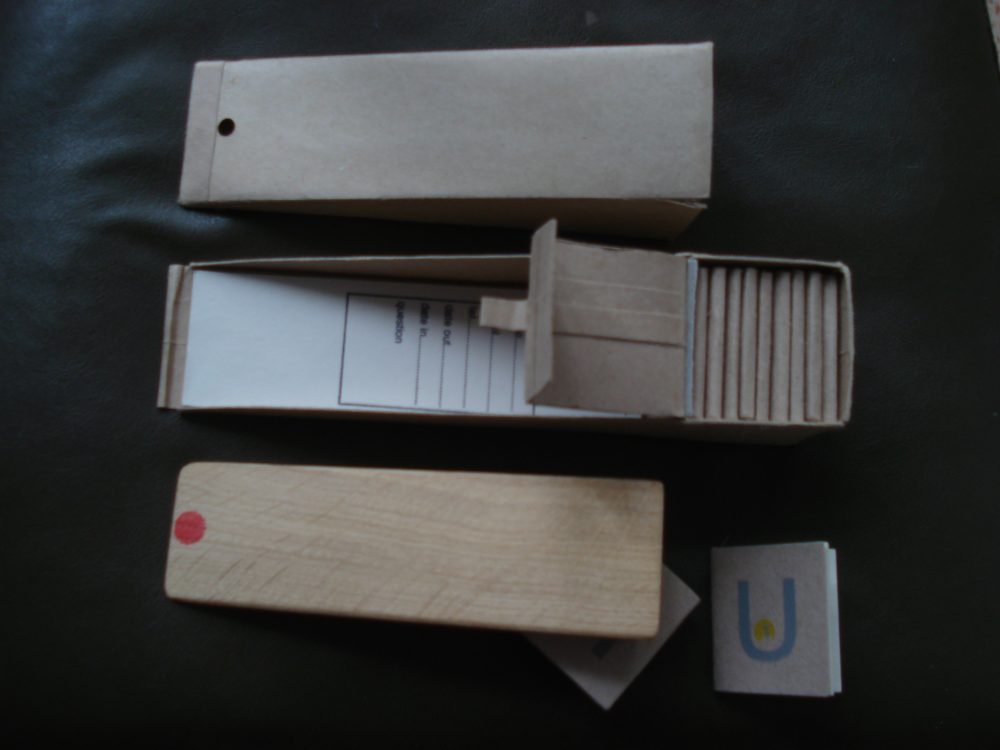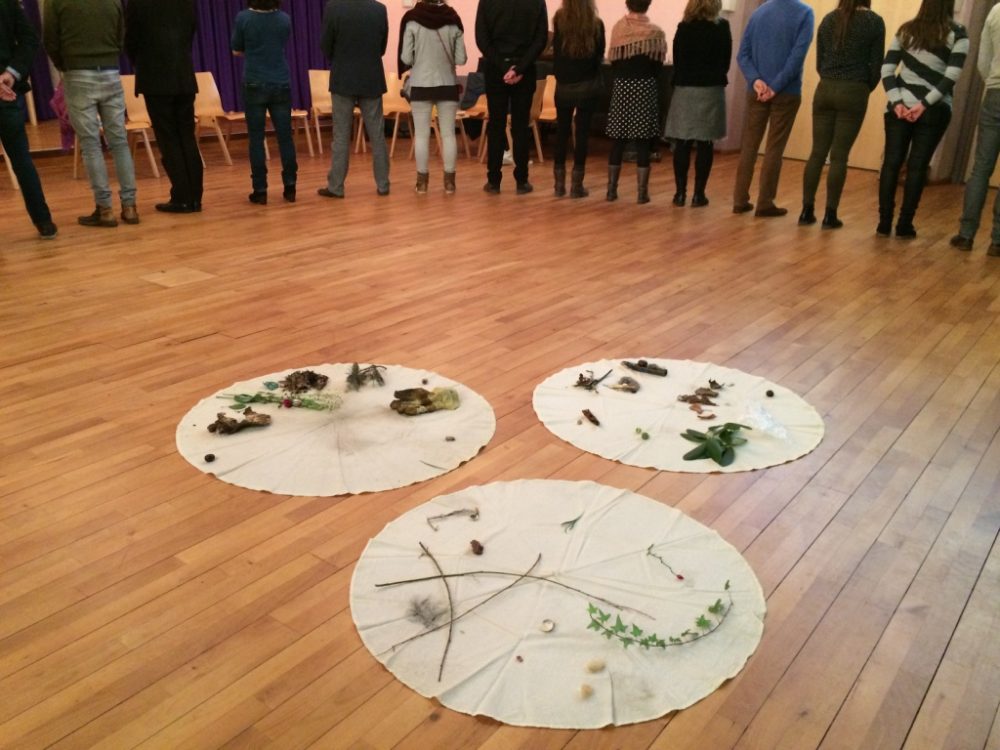University of the Trees
Instruments of Consciousness
The following ‘instruments of consciousness’ were created between 2006-11 and trialled with CCANW. They offer ways of developing new organs of perception, new eyes for the world, re-schooling of the senses, connecting inner and outer work, and exploring the human-nature relationship.
In addition to their physical forms, they work with the ‘invisible materials’ at the heart of the social sculpture ideas. It was this emphasis on what Beuys described as ‘sculpting with invisible materials of speech, discussion and thought’ that underpinned Beuys’ renowned expression ‘every human being is an artist’. To become a reality, such assertions needed to be explored in practice, and in relation to the needs and crises of our time.
Mobile Lab 1
The Tree Sling
The Tree Sling was developed to enable an individual to stand in a one-to-one relationship with a tree; to encounter a tree as another vertical living being, with similarities and differences. This encounter with a tree is part of the process of exploring the question ‘What is a Human Being? What is a Tree?’ It uses ‘bracketing/epoché’ methods from phenomenology to help with ‘reschooling our senses’ and to begin to ‘develop new organs of perception’. This methodology is practiced and does not need to be discussed, but can be, depending on the user group.

Mobile Lab 1: Tree Sling, notebook with carrying bag. Instrument © Shelley Sacks. Photos Chris Lewis.
The Sling instrument can be used with individuals or groups. It was used widely by Johanna with school groups in Haldon Forest. CCANW later funded a set of 30 Slings for use by teachers with entire classes of pupils 2006-8. The Slings have also been used in other contexts, for example, in conferences (Heinrich Böll Stiftung/Radius of Art, Berlin) and universities in Germany. The Slings are described as ‘mobile labs’ of this alternative university. We, using our ‘inner workspace’ or ‘inner atelier’ are, together with the physical instrument, a laboratory for new vision and understandings.
Mobile Lab 2
In-Sight Bands
In-Sight Bands were co-created with Johanna in 2007, based on the connective practice principles. The In-Sight Bands are cloth eye pads, like blindfolds, that stop one from looking outwards. First the wearer looks at something, for example a tree, with open eyes. Then, wearing the In-Sight Bands which inhibit outward seeing, one looks in the inner space and notes or shares what one has seen outwardly. This might be a simple description of the visual form, but usually it goes beyond this to sharing something about the attitudes and lenses with which we see. This is followed by looking outwards again and sharing insights that have arisen in the process.
This simple ‘instrument of consciousness’ makes one aware of what and how one sees, how it enables us to become aware of the lenses we see through, as well as the opportunity to change our habitual lenses.
The words ‘Mobile Lab 2’ are stamped on the In-Sight Bands, to highlight the fact that the wearer of a ‘mobile lab’ is a walking laboratory; that we have an inner workspace for ‘processing our experience’ and for coming to new understandings. 30 In-Sight Bands were created. They were used independently of the Sling process with a tree. However, used after the Sling process, they emphasise the ‘inner atelier’ space for ‘seeing what we see’, and ‘thinking about what we see’. They incorporate the ‘root method’ shared by all the ‘instruments of consciousness’.
Tree Bands
Tree Bands were used with ‘tree partners’ to create the Main Forum for the University of the Trees. These were researched and developed for Haldon Forest (2006-8) but also used in Darmstadt (2006-8), Oxford (2010), Berlin -Tiergarten/Goldene Else/Victory Statue (2011-16) and Kassel (2012 onwards).
Tree Band used at Darmstadt 2006. Instrument © Shelley Sacks. Photo Dieter Schumacher.
After Haldon Forest, where a more permanent UOT Main Forum existed, they were used to create a temporary workspace and Field of Awareness. Creating this temporary Field of Awareness became part of the ‘instrument of consciousness’ itself. It included a ‘field sensing’ process as used initially at CCANW to identify the place for the UOT Main Forum.

At first, the Tree Bands were made of thick grey felt, with gold embroidered text. After two years of deliberation with CCANW and many users in different countries, these were changed and made of yellow-orange organic cotton cloth with University of the Trees stamped on them. Although this was pragmatic for reducing production costs, the main reason for the change was to make the bands more visible both outwardly and then in the mind’s eye, so that one could more easily ‘perceive’ the field they created. A process derived from Goethean methodology was devised to enable groups to discover which trees were ‘able’ and appropriate to carry a band, and to become partners in creating the Field of Awareness.
Felt (2006) and Cotton Tree Bands (2008). Instruments and photo © Shelley Sacks.
When being used, the Tree Band is wrapped carefully around the trunk of a tree, at about two and a half metres above the ground. The band can be put on a tree to honour it and in some cases to highlight its challenging situation – perhaps because of illness, being overshadowed by other trees, or other difficult circumstances it lives in – noise, light pollution or fumes. It can also be put on a tree because it is a meaningful, inspiring place to meet. The Tree Band can remain on this tree permanently or be temporary. It can even be used for a one-day action in the area and taken down when the action is over.
As each yellow band is put on a tree, it invokes, acknowledges, and makes visible the ancient university that exists all over the planet. It is a university in which all the human beings are potentially students and teachers and the trees and other than human beings are the teachers as well.
Thought Wedges
The Thought Wedges were designed in 2009 to enhance exchanges and dialogue processes, by enabling a co-creative and reflective process for ‘working with questions’. Each Thought Wedge has a space to load a small booklet in the back. The question to be worked with, and further questions arising that the group agrees need to be kept ‘wedged’ open, are written in the small booklet and re-inserted into the wedge. At the end of an exchange or dialogue someone in the group agrees to take responsibility for continuing to work with the question, individually, or with the group. The Thought Wedges came in a container that contains nine additional small booklets, plus a pad to note significant insights.
Kit bag with Thought Wedges used in Australia 2010. Instruments and photo © Shelley Sacks.

The Thought Wedges were designed as part of the UOT kit, for CCANW to use with teacher’s groups in the CCANW building and in the UOT Main Forum in Haldon Forest. Although part of the CCANW kit, we did not get around to working with them much at CCANW. They were used in the UOT Darmstadt (2006), and in the Fierce Urgency of Now Climate Crisis conference (2009) at St James Palace and the Science Museum, London.
Shelley demonstrating the use of the Thought Wedge. Darmstadt ‘Stetig Wachsen’ Conference, Atelierhaus Vahle, 2006. Instrument and photo © Shelley Sacks.
Earth Forum
The Earth Forum is one of the most loved and used of the UOT ‘instruments of consciousness’. It enables a new form of dialogue with oneself and the world, for thinking together and for what UOT calls ‘living planning’. As the Earth Forum logo highlights, it is a place for ‘listening to oneself, listening to the other and listening to the world’.
Since the Earth Forum at CCANW in 2011 (which was a development from its early form in a South African village in 2002 related to the World Summit for Sustainable Development in South Africa that year), the Earth Forum instrument has been further developed and refined, and used with thousands of people in many contexts and countries including substantial use in South Africa, India, China, Germany, Holland, Portugal and the UK.

In addition to this use for the purpose of new vision and living planning, people can be trained to facilitate the Earth Forum process. After a four-day intensive training, participants are entitled to acquire an Earth Forum kit. This includes a Tree Band that enables them to create a temporary ‘field of awareness’ in which to guide an Earth Forum in their own context. Over 200 people have participated in the Earth Forum training in different regions of the world and continue to offer Earth Forum processes for a wide range of purposes.
Seven Deadly Sins
The Seven Deadly Sins ‘instrument of consciousness’ was designed in 2011 for groups and organisations and exhibited as part of the UOT-CCANW kit in a glass cabinet. This small handheld individual and group-monitoring instrument highlights the seemingly outmoded ‘seven deadly sins’. It enables us to identify and try to overcome them in our individual and collective work. It includes the UOT logo and reads: University of the Trees, and Nachhaltigkeit ohne Ich-sinn ist Unsinn (Sustainability without the I-sense is Nonsense). It was produced for the Überlebenskunst Festival in Berlin, 2011, and used as part of a connective practice with approximately 200 people.
Seven Deadly Sins 2011. Instrument and photo © Shelley Sacks.
Paradigm Shi[f)t
The Paradigm Shi[f)t ‘toilet roll’ was another small instrument that was created for CCANW in 2009 and intended to be used in a conference with the Forestry Commission. It was designed to raise the question about the need and potential to change deep habits in this time of Climate Crisis. It could be used in conjunction with the Thought Wedge. For several reasons this event did not take place.
The Paradigm Shift ‘Toilet Roll’ 2009. Instrument and photo © Shelley Sacks.
Enquiry Labs
UOT Enquiry Labs with a focus on Agents of Change, Basic Income, Ecological Citizenship and UOT itself were held in Haldon Forest 2007, Oxford 2008 ongoing and in London 2010.
The London Enquiry Lab in May 2010, exploring the nature and future of UOT itself, was hosted by Professor Caroline Tisdall. Other participants along with myself and Johanna included: Dr Chris Seeley, Dr Isis Brook, Dr Hildegard Kurt, Alan Kaplan, Dr Wolfgang Zumdick, Becs Gasson and Dr Graham van Wyk. A Tree Band was placed on an old oak in Caroline Tisdall’s garden on the banks of the Thames. This event was supported by the Social Sculpture Research Unit with additional funding from Caroline Tisdall.
© Shelley Sacks
Next Page
Timeline at CCANW 2006-2011
